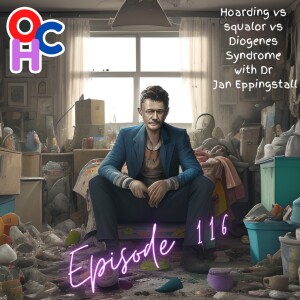
Friday Nov 03, 2023
Hoarding vs squalor vs Diogenes Syndrome with Dr Jan Eppingstall
In this episode, we're diving into the topic of squalor. Is it the same as hoarding? Can you have a squalid environment without hoarding being present? Compulsive hoarding and living in unsanitary conditions can have a profound impact on us. We'll explore the key factors and distinctions between hoarding and squalor, as well as the underlying causes that contribute to these behaviours. From acquired brain injuries and cognitive impairments to mental health disorders, we'll delve into the intricate web of reasons why people find themselves in these challenging situations. We'll also touch on the impact of substance misuse, the role of physical disabilities, and the link between hoarding and conditions such as dementia, schizophrenia, and OCD.
Join us as we explore the different characteristics, challenges, and possible solutions for hoarding and squalor. Whether you're facing hoarding tendencies yourself or seeking to understand these behaviours better, this episode is for you.
- Differentiating Hoarding, Squalor, Clutter, and Collecting
- Hygiene practices determined by culture.
- Unsanitary living caused by physical disability, dementia, illness, brain injuries, psychiatric disorders
- Long-term substance abuse damages brain's command centre
- Hoarding and squalor pose health risks
- Seek help for environmental neglect without shame
- The definition of unsanitary is determined by cultural hygiene practices, varying across cultures
- It relates to the reasonable person's judgment of cleanliness based on cultural norms.
- Obsessive-compulsive disorder (OCD) and contamination fears
- Substance abuse impairs decision making and damages the prefrontal cortex
- Hoarding and squalor pose health risks due to unhygienic living conditions and food safety issues.
- Prefrontal cortex damage explains dementia-related hoarding
- Unsanitary environments can result from socioeconomic factors such as poverty and limited access to sanitation services
- Lack of access to rubbish removal and funds for disposal
- Hoarding behaviours can lead to unsanitary living conditions due to hoarding severity, clutter volume, and difficulty discarding items. This attracts vermin and causes shame
- Living alone can lead to higher risk of unsanitary conditions
- Seek professional help, consider NDIS support for disabilities
- Clutter makes cleaning difficult
- Impairment in decision-making due to substance abuse
- Acquired brain injuries and neglect of personal and environmental hygiene
- Impairment of the command centre of the brain
- Deteriorating eyesight and its effect on recognising unsanitary areas
- Isolation and lack of support for seniors
- Loss and depression leading to neglect of hygiene
- Self-neglect among hoarders
- Characteristics of squalid living environments
- 1. Lack of purposeful clutter
- 2. Absence of emotional attachment to objects
- 3. Fear of objects that have touched other objects
- Root causes of squalid environments
- Waste management and food storage
- Socioeconomic Factors
- Access to education, poverty, and sanitation services
- Challenges faced by people living in public housing
- Role of support systems in overcoming squalor
- Seeking help from mental health professionals and GPs
- Overcoming shame
- Challenges Faced by Aging Hoarders
- Influence of injuries or loss on hoarding behaviours
- Avoiding unhelpful and meaningless labels
- Squalor cannot be overcome by willpower alone
- Emotional and functional purposes driving hoarding behaviour
Hosted on Acast. See acast.com/privacy for more information.
Comments (0)
To leave or reply to comments, please download free Podbean or
No Comments
To leave or reply to comments,
please download free Podbean App.